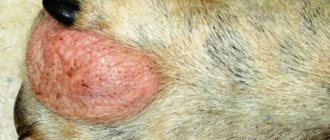Stomatitis in dogs is an inflammation of the mucous membranes of the mouth, including the cheeks, palate, tongue and even lips. In this article we will look at how it is infected and what the main symptoms are. And also how to treat and preventive measures.
It develops under the influence of pathogenic (harmful) microflora, which most often enters through wounds on the mucous membrane, or under the influence of infectious processes in the body.
Inflammation of the oral cavity in dogs is very common. Fortunately, this pathology cannot be called dangerous, but it has a rather serious effect on the pet’s condition - the structure of the mucous membrane is disrupted, swelling and soreness make it difficult to eat, which can even lead to exhaustion of the body.
The inflammation of the oral mucosa itself does not directly threaten the life of the pet, but sometimes stomatitis can be a symptom of a dangerous infectious disease.
Causes
Based on their occurrence, stomatitis is divided into primary and secondary.
Primary ones arise due to:
- Damage to the oral mucosa from food that is too hard, bones or foreign sharp objects (sticks).
- Irritation of the mucous membrane due to feeding the pet too cold or too hot food.
- Change of teeth in puppies (when new teeth erupt). Or if the bite is improperly ground in adult dogs, then the damage is caused by the sharp edges of their own teeth.
- Chemical injuries. This happens if the dog eats a poisonous plant, from certain medications or cleaning products.
In short, primary stomatitis occurs due to direct damage to the oral mucosa.
Secondary stomatitis occurs against the background of another disease:
- For infectious diseases. This option is the most dangerous, since many infectious pathologies threaten the pet’s life, and stomatitis is one of the first signs of some of these diseases. These include: parvovirus enteritis, canine distemper, leptospirosis and some others. It is very important to contact a veterinarian in a timely manner.
- Complications of non-communicable diseases. This happens against the background of other inflammations: the digestive tract or respiratory system. Often with sore throat and rhinitis.
Traumatic stomatitis
Traumatic stomatitis develops as a result of mechanical, thermal or physical trauma. This type of stomatitis occurs:
- superficial (burn of the mucous membrane by hot tea)
- deep (burn with a strong alkali or acid, strong biting of the mucous membrane)
Acute mechanical stomatitis: rare, it can be caused by trauma to the mucous membrane when biting the cheek, tongue, lip while eating, an attack of epilepsy, a blow, trauma during dental treatment and other traumatic factors.
It is manifested by pain, hyperemia, swelling at the site of injury, erosion. With secondary infection, the wound can develop into long-term non-healing ulcers. Most often, traumatic stomatitis is acute, but can also be chronic, for example, constant biting of the cheeks under stress, chronic injury from braces, a sharp tooth edge, or a bad crown. As a result of trauma, painful erosions or ulcers with jagged edges form on the mucous membrane, which can become infected.
The cause of physical injury is most often a thermal burn due to contact with hot liquid, inhalation of steam, or exposure to fire, the latter, as a rule, accompanied by damage to the respiratory tract. The lesion is most often located on the tip of the tongue, lips, and the front of the palate. The mucous membrane becomes swollen, red, painful, and blisters may form, which then burst. With deep damage, the mucous membrane dies, and the damage involves muscles and even bone.
Chemical stomatitis occurs when burned with acid or alkali. In everyday life, this is most often acetic acid; also at a dental appointment, burns can occur with various drugs (phenol, formaldehyde, alcohol, hydrofluoric acid, etc.). The depth of damage depends on the damaging substance and its concentration, and the duration of exposure. First, the mucous membrane becomes bright red and painful, and with severe lesions, foci of necrosis then appear within a few hours.
In case of burns with acids, alkalis, or thermal burns, it is recommended to call an ambulance!
Types and symptoms
There are several types of stomatitis, which do not differ much in clinical manifestation and method of treatment in the future.
Regardless of the type of inflammation, the following symptoms are observed with stomatitis:
- Soreness. This can be noticed when the dog is eating. She will choose the softest parts of the food and chew carefully, constantly interrupting. Or, on the contrary, he will not chew at all, trying to immediately swallow the pieces. Food may fall out of the mouth.
- Partial or complete refusal to eat.
- Unpleasant, sometimes even putrid odor from the mouth.
- Increased salivation.
- Dental problems.
- Temperature increase.
Let's take a closer look at the different types of stomatitis.
Viral stomatitis
Herpetic stomatitis
Caused by the herpes virus of the first, less often the second type.
It accounts for 80% of all stomatitis and occurs mainly in children, less often in adults. The prevalence of herpes simplex virus ranges from 65% to 90%8. Infection occurs through airborne droplets and household contact. More common is recurrent herpetic stomatitis, which is manifested by itching, burning, slight soreness in the oral cavity, then vesicles (bubbles) appear, which burst and heal after 7-10 days.
During primary infection, acute herpetic stomatitis occurs; it is characterized by general symptoms such as fever, weakness, aches in the muscles and joints, the degree of these manifestations depends on the severity of the disease. As a rule, the acute form occurs in children.
Varicella zoster virus infection
The mildest form, in which the mucous membrane of the tonsils is affected. The palatine tonsils are not very enlarged, the mucous membrane of the throat is red, there is no plaque or pus.
Stomatitis with measles
Measles is an acute viral, highly contagious disease that is caused by the Polinisa virus and is transmitted by airborne droplets. The disease is extremely contagious. It is characterized by a rise in temperature, symptoms of ARVI, a rash on the face, neck, and then the whole body. In the oral cavity, Filatov-Koplik spots and stomatitis occur, which is characterized by hyperemia, swelling of the mucous membrane and white plaque. Nowadays, thanks to vaccination, this disease practically does not occur.
Ulcerative
Ulcerative stomatitis is easier to detect than others. It has quite clear clinical signs:
- The pain is pronounced.
- Sores are clearly visible on the gums, cheek mucosa, tongue and inner side of the lips (sometimes on the outer side). They look like deep, limited, rounded inflammations on the mucous membranes.
- Chomping is typical, even when the dog is at rest (not eating).
Ulcerative stomatitis can develop into gangrenous stomatitis.
Allergic stomatitis
They arise as a reaction of the mucous membrane to an allergen. An allergic agent can be toothpastes, mouthwashes, food, medicines, materials for crowns, fillings, etc. Allergies often occur to removable dentures. The mucous membrane is affected precisely at the point of contact with the damaging agent, for example, the hard palate under a removable denture. With allergic stomatitis, the mucous membrane is swollen, red, bubbles appear, which burst with the appearance of painful erosions.
Allergic stomatitis also includes chronic recurrent aphthous stomatitis , it begins with swelling and burning, then a painful aphtha appears, and then a healing period begins. This disease is characterized by constant relapses with a certain frequency.
Treatment
First aid
Before contacting the veterinarian (and contact him in any case), you can alleviate the dog's condition.
First, eliminate solid rough food from your pet's diet. There should be plenty of water.
Next, you can treat the dog’s mouth with a disinfectant solution yourself.
DO NOT APPLY WITH HUMAN OINTMENTS AND GELS.
Use those drugs that you are sure are harmless. For example:
- Furacilin solution 1 to 10,000.
- 3% boric acid solution.
- You can also use herbal infusions, such as chamomile or calendula.
Your next action should be a visit to the veterinary clinic.
Treatment
The treatment regimen depends on the type and stage of inflammation, so all medications should be prescribed exclusively by a veterinarian.
For purulent stomatitis, you cannot do without a course of antibiotics and regular treatment of the oral cavity with disinfectant solutions.
For the treatment of ulcers the market uses:
- For cauterization - a solution of iodine and glycerin 1 to 4, respectively.
- Syntomycin emulsion.
- Silver nitrite solution.
If the dog refuses to eat (due to severe inflammation), nutrient drips are prescribed.
If stomatitis is secondary, then you first need to overcome the original disease.
Diagnostics in a veterinary clinic
In addition to a visual examination and medical history, diagnosis requires clinical and biochemical blood tests, a urine test and an oral smear. Based on the results obtained, the veterinarian identifies the exact cause of the disease in order to select individual treatment to eliminate it.
Dog care
During illness, the dog needs special care.
The diet must necessarily consist of soft food. You can make puree from meat and vegetables, feed porridge. If your pet tolerates fermented milk products well, you can give kefir or yogurt.
Food must be warm. If you feed your pet with ready-made food, then, for a while, give up dry food and buy canned food and pates from the same line of food.
Also, part of caring for a pet during illness is treating the oral cavity with special solutions. They will be prescribed by your veterinarian, some of which are described above.
To prevent the dog from ingesting the drug, we recommend that the treatment be carried out by irrigating the mucous membrane. To do this, you need to place a special solution in a vessel with a spray bottle.
Prevention and risk group
All dogs can develop oral inflammation, regardless of age or breed. However, we can separately highlight:
- Dwarf dog breeds. They are more likely than others to have problems with their teeth and the entire oral cavity.
- Puppies aged 3-7 months. It is during this period that teeth change.
- Dogs that are fed roughage are given bones, etc.
To prevent stomatitis, you must follow some rules:
- Be responsible about your pet's diet.
- Don't forget that dogs also need to maintain oral hygiene. She won’t brush her own teeth—that’s your concern.
- Timely vaccinations and treatments against parasites are mandatory.
- If you notice that your dog is chewing on a stick or other foreign object, inspect your pet's mouth. Particles can get stuck in the teeth and injure the mucous membrane.
Stomatitis caused by fungi
Candidal stomatitis is a fungal disease caused by fungi of the genus Candida.10 Young children and the elderly are more often affected; people with diabetes and xerostomia (dry mouth), pregnant women and people with weakened immune systems are also at risk. Elderly people wearing removable dentures often get sick.
The main symptom of fungal stomatitis is a burning sensation and the presence of a white, cheesy coating, when removed, a swollen, red mucous membrane appears. The general condition of adults with candidal stomatitis is practically not affected.
Popular questions
How to examine a dog's mouth?
To begin with, you need an assistant, and if the dog is large, then two are better.
Not every pet will happily agree to let you examine its mouth. It will need to be fixed.
If you doubt the calmness of your pet or your ability to open its mouth, contact your veterinarian immediately.
To open the jaws you will have to use both hands.
All actions must be performed with caution so as not to harm the pet.
You should not use excessive force, and then your four-legged friend will “meet you halfway.”
Place one hand on the bridge of the dog’s nose, as if covering it, so that the index finger and thumb (from different sides) can be inserted behind the canines. This creates a gap between the upper and lower jaws. Using the fingers of your other hand, lower your lower jaw down.
Briefly about the main thing
- Stomatitis is an inflammation of the mucous membranes of the oral cavity.
- Inflammation can be primary if it is caused directly by damage to the mucosa. And secondary, in cases where it develops against the background of another disease, often infectious.
- Stomatitis can be catarrhal, ulcerative, atrophic or purulent. But regardless of the type of inflammation, the symptoms are similar.
- First of all, owners notice a violation of the act of chewing and a refusal to eat solid food.
- At home, you can help your dog only by replacing regular food with soft food.
- You can treat the oral cavity with a disinfectant solution (an aqueous solution of furatsilin or a slightly pink solution of potassium permanganate).
- For prevention, periodically inspect your pet’s mouth.
- Your dog's oral hygiene is your responsibility. Don't forget to brush your pet's teeth.
Have we answered your question fully enough? If not, post your question in the comments below and our veterinarian will answer it.
Did you like the article? Share it with your friends on social media. networks. This will help them get useful information and support our project.











